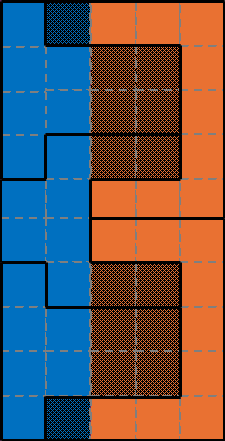Ranked Choice Voting (RCV)
Rank up to All, One (1) Winner
Voters rank their candidates putting a 1 next to their first choice, 2 next to their 2nd choice and so on. If the voters preferred candidate is eliminated, their votes are distributed to the remaining preferred candidates.
Test Your Knowledge
This Webpage and Video Have a Quiz you can take to test your knowledge and understanding of the content. This lesson is part of a larger education series.
| Rank | Candidate Selection |
|---|---|
| 1st Choice | |
| 2nd Choice | |
| 3rd Choice | |
| 4th Choice | |
| 5th Choice | |
| 6th Choice | |
| Candidate | Faction | Votes | Share |
|---|---|---|---|
| D | 🟨 Yellow | 200,000 | (50%) |
| - F | - 🟩 Green | 110,000 | 11% |
| - J | - 🟪 Purple | 10,000 | 1% |
| - B | - 🟧 Orange | 160,000 | 16% |
| - A | - 🟥 Red | 20,000 | 2% |
| G | 🟦 Blue | 300,000 | (39%) |
| - J | - 🟪 Purple | 30,000 | 3% |
| - B | - 🟧 Orange | 50,000 | 5% |
| - A | - 🟥 Red | 10,000 | 1% |
| - | Dropped | 110,000 | 11% |
RCV Vote Share
After voters rank their candidates, the candidate with the least votes is eliminated first and their voters 2nd choice votes are redistributed.
RCV Outcome
Unlike Plurality Voting, Ranked Choice Voting gives voters alternative choices. However, as shown below, large percentages of the population are still locked out of government at any given time.
RCV Seat Control
In this example, D🟨(Yellow) is aware that their victory was due in part to the support from F🟩(Green), J🟪(Purple), B🟧(Orange), and A🟥(Red).
RCV Committee Control
Processing Ranked Choice Results
After voters rank their candidates, the candidate with the least votes is eliminated first and their voters 2nd choice votes are redistributed. This process repeats until One (1) Candidate reaches a majority or there is only one candidate standing. Unlike two-round voting (not depicted), voters are able to rank their choices in a single ballot rather than having to return to the polls to vote in a second ballot. In this example, voters from other factions coalesced around D🟨(Yellow) to achieve victory of major rivals G🟦(Blue) and B🟧(Orange).
RCV Round 1
A🟥(Red) has the fewest votes and is eliminated. Their votes are redistributed to voters' next preferences.
RCV Round 2
In the second round, B🟧(Orange) received 40,000 votes from A🟥(Red), while 10,000 votes were dropped due to no further preferences. The next candidate to be eliminated is J🟪(Purple).
RCV Round 3
In the third round, F🟩(Green) received 40,000 votes (4%) from J🟪(Purple), G🟦(Blue) received 30,000 votes (3%) from J🟪(Purple), and 10,000 votes (1%) were dropped. The next candidate to be eliminated is F🟩(Green).
RCV Round 4
In the fourth round, D🟨(Yellow) received 100,000 votes (10%) from F🟩(Green), which includes 10,000 votes (1%) from the third-choice voters of J🟪(Purple). B🟧(Orange) received 10,000 votes (1%) from F🟩(Green). The rest of J🟪(Purple) and 10,000 votes (1%) from F🟩(Green) were dropped, bringing the dropped total to 60,000 votes (6%). The next candidate to be eliminated is B🟧(Orange).
RCV Round 5
In the fifth and final round, D🟨(Yellow) received 160,000 votes (16%) from B🟧(Orange) and 20,000 votes (2%) from A🟥(Red)'s third-choice voters, securing a total of 50% and winning the election. G🟦(Blue) received 50,000 votes (5%) from B🟧(Orange) and 10,000 votes (1%) from A🟥(Red)'s third-choice voters. The remaining votes were dropped, increasing the dropped total to 11%.
Two Party Deadlock
Like in FPTP, under RCV Factions are forced to strategically vote to gain a competitive edge. However, unlike FPTP, the Spoiler Effect is not present.
| Faction | Count | Vote Share |
|---|---|---|
| 🟧 Orange | 510,000 | 49% |
| 🟦 Blue | 490,000 | 51% |
Strategic District Drawing
Because RCV also tends toward two parties, Power structures under RCV can draw electoral maps so that future election results are likely to favor the status quo.
| Faction | Count | Vote Share |
|---|---|---|
| 🟧 Orange | 600,000 | 60% |
| 🟦 Blue | 400,000 | 40% |
| 🟧 Orange | 🟦 Blue |
|---|---|
| 2 | 3 |

A More Representative Way: Proportional Ranked Choice Voting (PR-RCV)
No other system comes close to having the final outcome match the voters interests.
Ranked Choice Voting (RCV)
Proportional Ranked Choice Voting (PR-RCV)
Rank up to All, Multi-Winner [>=5]
PR-RCV is similar to RCV except there are multiple winners. This can be accomplished by increasing the number of winners per district OR by combining several districts into one larger district.
| Candidate | Faction | Count | Share |
|---|---|---|---|
| B | 🟧 Orange | 170,000 | (20%) |
| A | - 🟥 Red | 30,000 | 3% |
| D | 🟨 Yellow | 110,000 | (20%) |
| E | - 🟨 Yellow | 90,000 | 9% |
| F | 🟩 Green | 120,000 | (20%) |
| C | - 🟧 Orange | 70,000 | 7% |
| A | - 🟥 Red | 10,000 | 1% |
| G | 🟦 Blue | 200,000 | (20%) |
| J | 🟪 Purple | 80,000 | (15%) |
| I | - 🟦 Blue | 20,000 | 2% |
| G | - 🟦 Blue | 40,000 | 4% |
| H | - 🟦 Blue | 10,000 | 1% |
| · | Dropped | 50,000 | 5% |
Protects Diversity
Supports all political groups all the time.
Breaks Deadlocks
Resolves stalemates in two-party systems using unrepresentative voting methods like First Past the Post.
Enhances Efficiency
Improves the functioning of one-party/No-Party states by removing unproductive incentives in autocratic systems.
Empowers Party Members
PR-RCV Supports all political groups all the time.
Increases Leverage for Legislators
Provides individual legislators more power to represent their jurisdictions in negotiations with faction leadership.
Ensures Neutrality
Enables speakers, chairs, civil officers, and non-political appointees to remain truly neutral by balancing political pressures.
Promotes Cooperation
Encourages cooperative behavior and reduces combative behavior by creating a balanced political environment by making single faction majorities unlikely.
